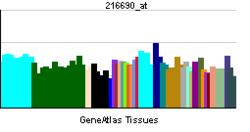- OR7C1
-
Olfactory receptor, family 7, subfamily C, member 1 Identifiers Symbols OR7C1; CIT-HSP-146E8; HSTPCR86P; OR19-5; OR7C4; TPCR86 External IDs MGI: 3030704 HomoloGene: 115523 GeneCards: OR7C1 Gene Gene Ontology Molecular function • receptor activity
• G-protein coupled receptor activity
• olfactory receptor activityCellular component • plasma membrane
• integral to membraneBiological process • G-protein coupled receptor protein signaling pathway
• spermatogenesis
• sensory perception of smell
• response to stimulusSources: Amigo / QuickGO RNA expression pattern 
More reference expression data Orthologs Species Human Mouse Entrez 26664 57251 Ensembl ENSG00000127530 ENSMUSG00000066899 UniProt O76099 n/a RefSeq (mRNA) NM_198944 NM_146904.1 RefSeq (protein) NP_945182 NP_667115.1 Location (UCSC) Chr 19:
14.91 – 14.91 MbChr 9:
19.98 – 19.98 MbPubMed search [1] [2] Olfactory receptor 7C1 is a protein that in humans is encoded by the OR7C1 gene.[1]
Olfactory receptors interact with odorant molecules in the nose, to initiate a neuronal response that triggers the perception of a smell. The olfactory receptor proteins are members of a large family of G-protein-coupled receptors (GPCR) arising from single coding-exon genes. Olfactory receptors share a 7-transmembrane domain structure with many neurotransmitter and hormone receptors and are responsible for the recognition and G protein-mediated transduction of odorant signals. The olfactory receptor gene family is the largest in the genome. The nomenclature assigned to the olfactory receptor genes and proteins for this organism is independent of other organisms.[1]
Contents
See also
References
Further reading
- Vanderhaeghen P, Schurmans S, Vassart G, Parmentier M (1997). "Specific repertoire of olfactory receptor genes in the male germ cells of several mammalian species". Genomics 39 (3): 239–246. doi:10.1006/geno.1996.4490. PMID 9119360.
- Vanderhaeghen P, Schurmans S, Vassart G, Parmentier M (1997). "Molecular cloning and chromosomal mapping of olfactory receptor genes expressed in the male germ line: evidence for their wide distribution in the human genome". Biochem. Biophys. Res. Commun. 237 (2): 283–287. doi:10.1006/bbrc.1997.7043. PMID 9268701.
- Fuchs T, Malecova B, Linhart C et al. (2003). "DEFOG: a practical scheme for deciphering families of genes". Genomics 80 (3): 295–302. doi:10.1006/geno.2002.6830. PMID 12213199.
- Strausberg RL, Feingold EA, Grouse LH et al. (2003). "Generation and initial analysis of more than 15,000 full-length human and mouse cDNA sequences". Proc. Natl. Acad. Sci. U.S.A. 99 (26): 16899–16903. doi:10.1073/pnas.242603899. PMC 139241. PMID 12477932. http://www.pubmedcentral.nih.gov/articlerender.fcgi?tool=pmcentrez&artid=139241.
- Malnic B, Godfrey PA, Buck LB (2004). "The human olfactory receptor gene family". Proc. Natl. Acad. Sci. U.S.A. 101 (8): 2584–2589. doi:10.1073/pnas.0307882100. PMC 356993. PMID 14983052. http://www.pubmedcentral.nih.gov/articlerender.fcgi?tool=pmcentrez&artid=356993.
External links
This article incorporates text from the United States National Library of Medicine, which is in the public domain.
Class II
(tetrapod specific receptors)Family 1Family 2A1 · A2 · A4 · A5 · A7 · A12 · A14 · A25 · A42 · AE1 · AG1 · AG2 · AJ1 · AK2 · AP1 · AT4 · B2 · B3 · B6 · B8 · B11 · C1 · C3 · D2 · D3 · F1 · F2 · G2 · G3 · G6 · H1 · H2 · J1 · J2 · J3 · K2 · L2 · L3 · L5 · L8 · L13 · M2 · M3 · M4 · M5 · M7 · S2 · T1 · T2 · T3 · T4 · T5 · T6 · T8 · T10 · T11 · T12 · T27 · T29 · T33 · T34 · T35 · V1 · V2 · W1 · W3 · W5 · Y1 · Z1
Family 3Family 4Family 5Family 6Family 7Family 8Family 9Family 10Family 11Family 12Family 13Categories:- Human proteins
- Transmembrane receptor stubs
- G protein coupled receptors
Wikimedia Foundation. 2010.
